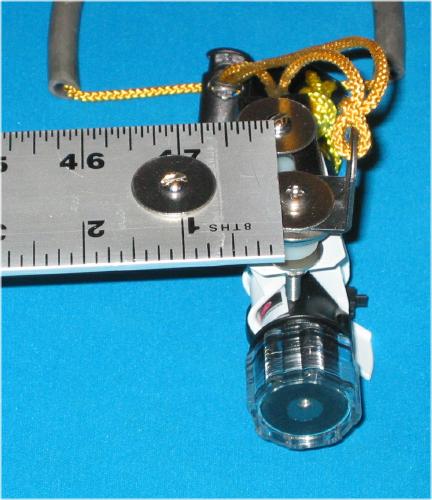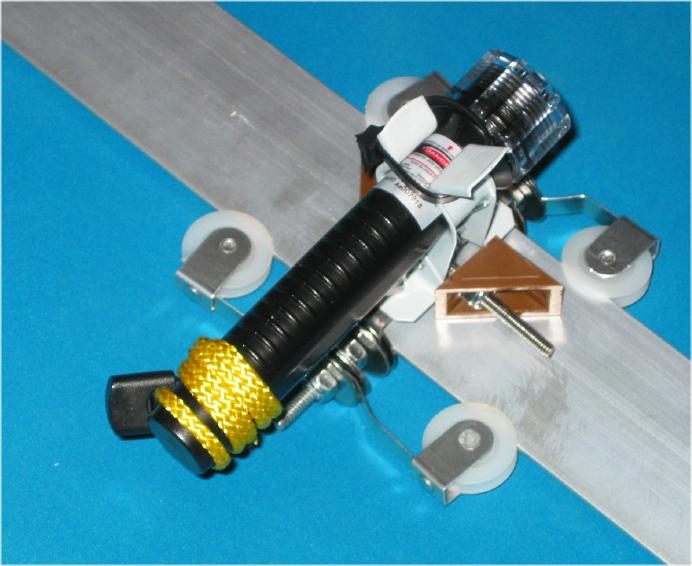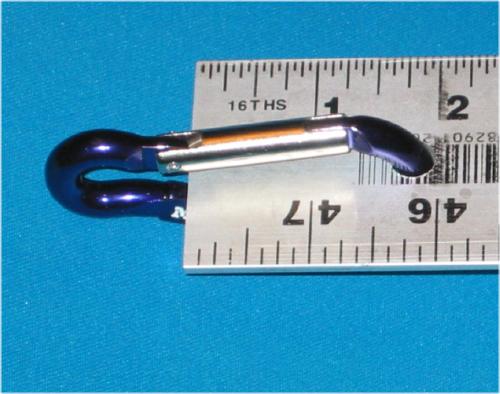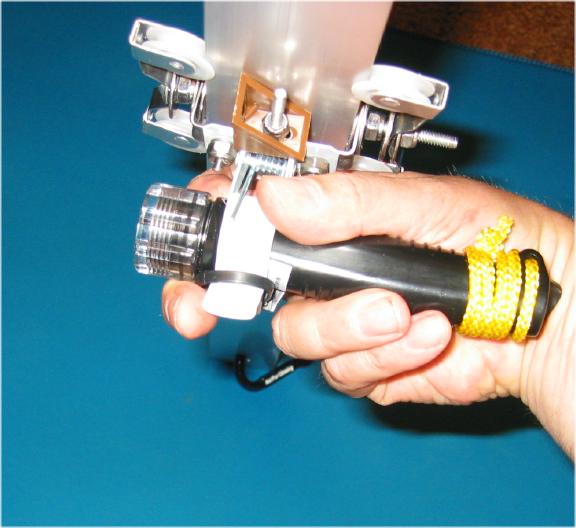
Navigation: An Underwater Laser Equipped "Yardstick"
by
Larry "Harris" Taylor, Ph.D.
This
material is copyrighted and all rights retained by the author. This article is
made available as a service to the diving community by the author and may be
distributed for any non-commercial or Not-For-Profit use.
All
rights reserved.
This is an extension of the article on adding underwater lasers to common carpenter's tools (mapping) to facilitate underwater mapping techniques.
Go To: Home About "Harris" Articles Slides War Stories Editorials Links Fini
There are times when it is necessary to measure or estimate the size of fragile objects, or moving living critters where use of a standard straight edge ruler or surveyor's tape is cumbersome or down-right impossible. To facilitate these type of measurements, underwater lasers can be added to a common yardstick. While there are undoubtedly many ways of doing this (dependent on access to quality machinists and metal working tools), below is one example of a laser distance measuring tool that can be assembled with minimum skills and tools. Since emitted laser light travels in a straight line, the distance between the spots where the laser beams strike a distant object will be the same as the distance indicated on the yardstick. This tool uses 2 underwater laser pointers sold for recreational scuba (100 fsw working depth with 100 fsw claimed visibility): one fixed at position zero and a sliding laser that can be adjusted from 3 to 45 inches to indicate the distance between two observed spots of laser light. A 4 foot measuring stick is used because typical yard/meter sticks are too thin and flexible to support the weight of the traveling laser carriage. The tool is shown below.

Laser Yardstick -Top View

Laser Yardstick -Bottom View
Assembling this tool is an exercise in browsing hardware stores for parts that can be adapted to provide the support for the lasers while providing a reasonably convenient method of measurement. This particular assembly used a variety of stainless steel pan machine screws, washers and locking hex nuts, angle irons left over from assembling multiple video tape/DVD storage cabinets, garage spring clips, and sliding wheels that are sold as aluminum screen door replacement parts.
The Fixed Laser
The fixed laser is mounted so that the laser is emitted from the zero point of the measuring stick. While the selected spring clip is convenient, it does not hold the laser in a position parallel to the mounting holes. So, without adjustment, the laser beam will not be perpendicular to the measuring stick. However, with a little adjustment of the supporting angle pieces, the laser can be oriented to lie directly under the zero point of the ruler while projecting a perpendicular to the ruler laser emission. Adding a black polypropylene tie-wrap acts as a security precaution to assist in keeping the laser in the holder. Two roller wheels (white disks between the stainless steel washers and the spring clip in the illustration below) were added to put the fixed laser at the same level below the yardstick as the moving laser. Finally, a wrist lanyard is included to assist the diver in maintaining possession of the device should the diver need hands for something other than using the tool.

Fixed Laser-Bottom View

Fixed Laser-Top/Front View
The Movable Laser
The moving laser carriage is assembled with machine screws, washers, a spring clip and 4 wheels. The wheels, sold as replacement parts for aluminum screen doors, move smoothly along the edge of the measuring stick. The long machine screw holding the assembly together serves as an measurement index to locate the distance from the zero point (see top view). The laser assembly resting on two angle irons tends to rotate around the long screw (the one marking the distance), so it is necessary to restrict this rotation (brown triangular component in the image below).
The locking nuts holding the assembly together are adjusted so that the tension from the wheels holds the carriage in a fixed location while also allowing the device to be moved with a minimum of effort.

Moving Laser- Bottom View

Moving Laser- Top View
Stop
A carabineer at one end of the "stick" provides a convenient attachment point to hook the device to a line for water entry/exit. (Using a line for tool entry/exit minimizes task loading on the diver while allowing for accurate accounting of tools in use.) In addition, the carabineer serves as a stop to prevent the moving laser carriage from sliding off the tool. (Since the measuring stick is hard aluminum, the hole for the carabineer is best drilled with a drill press.) The stop limits the working distance of this tool to a maximum of 45 inches.

Grip
The clip holding the moving laser provides a convenient hand-hold. This allows for rapid change of the distance between the fixed and moving points while providing support for the tool. Since the laser is only attached at a single point, the user needs a little bit of practice to move the laser as a unit without distorting its position.

Calibration
Since there is some flexibility in this mounting scheme, it makes sense to check the tool prior to any use. This is done by turning on both lasers and shining them on another 4 foot measuring stick. If the lights strike a distance different from the intended one, then the various mounting bolts can be adjusted until the two lasers are illuminating the distant ruler at the same point as on the measuring tool. The tool calibration should be checked before each use.
Technique
Since measuring and recording are separate tasks, this tool is best used within a buddy team ... one diver to use the laser yardstick and another to record the observations.
The use of the underwater lasers depends upon water visibility and ambient lighting, but for measuring distances, the tool is typically best used when the distance between tool and measured object is less than 50 feet.
Conclusion
Recreational underwater lasers can be used to build a reasonable low-cost distance measuring tool.
Go To: Home About "Harris" Articles Slides War Stories Editorials Links Fini
About
The Author:
Larry "Harris" Taylor, Ph.D. is a biochemist and Diving Safety Coordinator at the University of Michigan. He has authored more than 200 scuba related articles. His personal dive library (See Alert Diver, Mar/Apr, 1997, p. 54) is considered one of the best recreational sources of information In North America.
All rights reserved
Use of these articles for personal or organizational profit is specifically denied.
These articles may be used for not-for-profit diving education